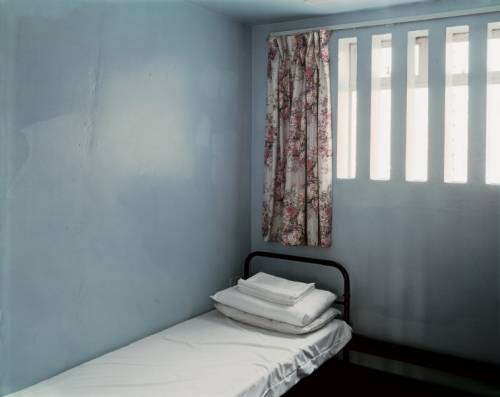In his series “Maze”, Donovan Wylie was granted exclusive access to the Maze Prison when it was decommissioned in 2003. Paramilitary prisoners of both side were incarcerated in the Maze, sorted into H Blocks depending on their affiliation, and this is where the Blanket and Dirty Protests of the late 1970s and the 1981 Hunger Strike took place. The hospital, where prisoners on Hunger Strike died, and some of the H Blocks are protected buildings but other parts of the prison have been demolished, in order to build a football stadium among other things. However, in January 2009, this “redevelopment” plan was cancelled and what will become of the Maze site remains uncertain and subject to controversy. It is possible that Donovan Wylie’s photographs are the last memorials of the events who took place there.
I’ve done a bit of research ( source 1, source 2, source 3). From one source, it seems “The Maze” was originally called “Long Kesh Prison” and renamed to “H.M.P. Maze” in the mid 1980s in order to distantiate it from the brutal treatment of prisoners in the 1970s and early 1980s that tainted the name “Long Kesh” in collective memory. It is possible that the specific name that individual pick to refer to the prison may imply their political views on the conflict. From another source, it seems the prison was renamed from “Long Kesh” to “Maze” in 1976, at the same time as the prisoners lost their Special Category status (political prisoner as opposed to common criminal) and the H-Blocks built to replace former huts. I am unsure of the date the renaming took place but different sources seem to corroborate that using different names may have political connotations. However, given the sensitivity and controversy of the whole subject, I cannot be sure of the reliability of specific sources and do not have enough insider knowledge to guarantee the degree of truth of information I find.
This research made me more aware of the difficulty of creating artworks on a politically sensitive subject, because every little detail such as the choice of a word can spark unplanned controversy. I feel I must be very careful when creating artwork on a political theme, such as my Disciplinary Institutions series. An artist making political art must be very careful to thoroughly research their subject because if they unwittingly say something inacurate, or something that implies political leaning they were not aware of and willingly trying to convey, they can make a fool of themselves or even be used as an unwitting pawn in a political quarrel.
***
Identical cells painted various colors. I do not know if colors were specific to different H Blocks and, if this was the case, whether they had a political symbolism or were random.





The same place in the process of being demolished.



In an interview, Donovan Wylie comments on how he interpretated the place, its atmosphere and function photographically: “the trick of the project was to try to understand the psychology of it. The building is a hybrid between a civilian prison and a military prison, but the whole thing is a machine and every part in it is a component and it all works together. Once you understand it as a machine, you can deconstruct it as a machine, photographically. Then you fully understand the shape of it, why it doesn’t have any steps, why there are so many layers to it, why it is so uniform.”

So many lives were destroyed within those walls. So many families were destroyed. Good men gave up their lives in the name of freedom within those walls.
Oh My God!
We were so shocked to see that the prison is almost totally demolished. We had no idea! They are building houses there! It makes me so mad and sick. Destroying history, it’s a shame. They even sent us away. They don’t want to talk about it; well, they got my attention now!
I really want to support some kind of protest to save the only building that is still standing. Do you know how I can find such protest?
Greeting from Holland, Trudy.